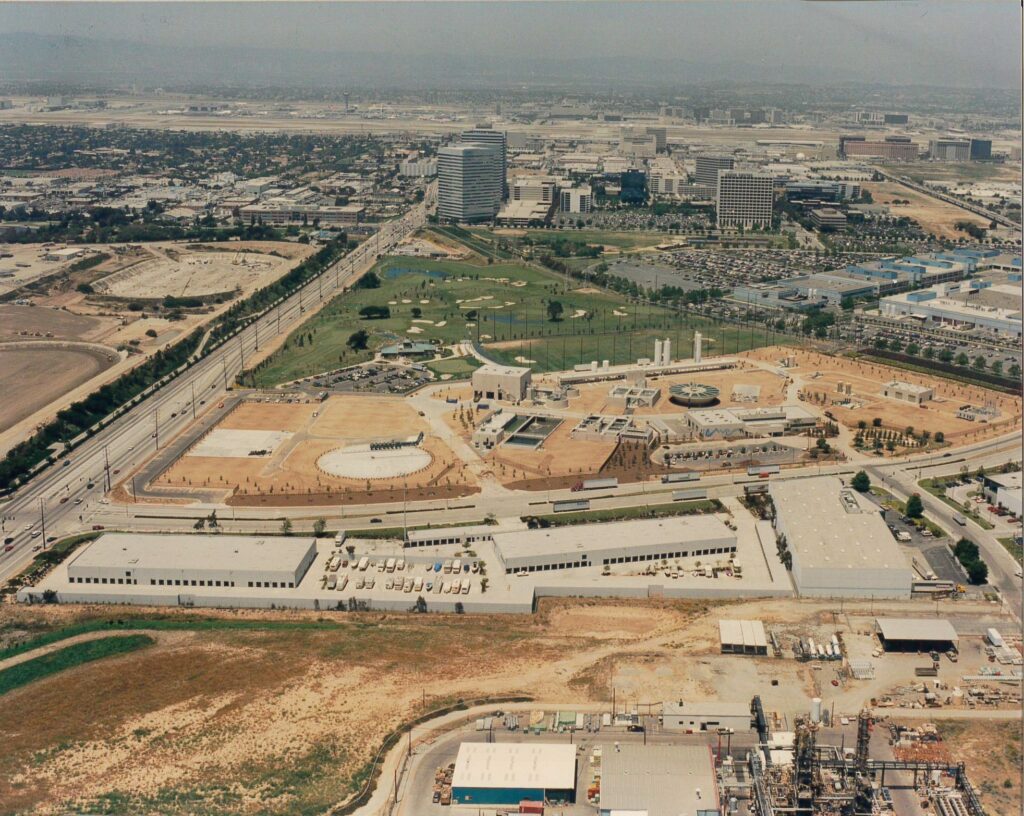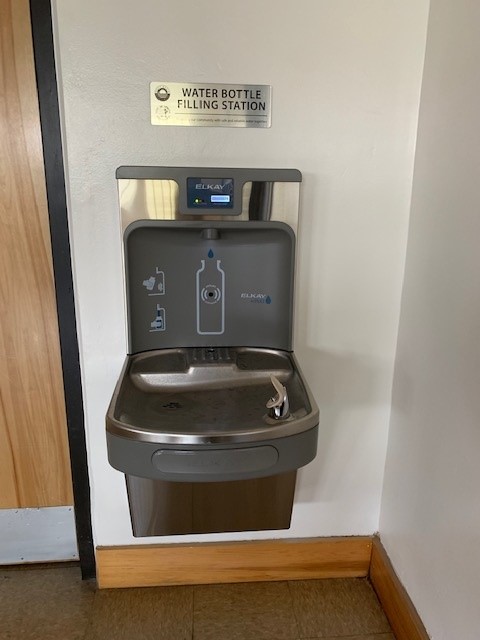West Basin Commemorates 75 Years of Water Reliability
1947-2022
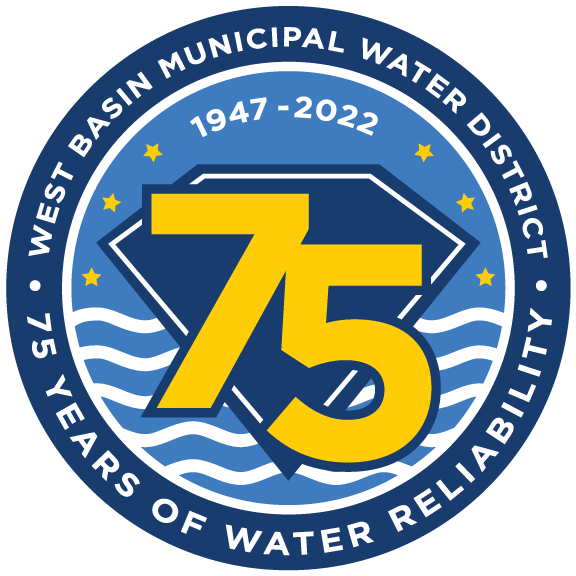 West Basin is celebrating more than seven decades of ensuring water reliability for its service area communities in coastal Los Angeles. It has been 75 years since West Basin was formed by a vote of the people in 1947 to make local water supplies more reliable through the protection of local groundwater sources and identification of new water sources.
West Basin is celebrating more than seven decades of ensuring water reliability for its service area communities in coastal Los Angeles. It has been 75 years since West Basin was formed by a vote of the people in 1947 to make local water supplies more reliable through the protection of local groundwater sources and identification of new water sources.
Since its formation, the District has been delivering on its mission of water reliability and establishing drought resiliency through balanced and cost-effective water supply diversification. 75 years later, West Basin remains committed to its mission to “provide a safe and reliable supply of high-quality water to the communities it serves” and to being an innovative leader in the water industry.
About History

1947
West Basin Municipal Water District is Formed
West Basin Municipal Water District is voted into existence in November 1947 after two attempts:
- Jan. – First attempt to form West Basin Municipal Water District fails.
- Nov. – Second attempt to form West Basin Municipal Water District succeeds by an 8:1 margin.
Its mission was to both protect the existing water supply (groundwater) and increase reliability by identifying new supplemental supplies of water.
1987-1992
Unprecedented Drought in California
California experiences one of the most serious droughts in its history. West Basin’s innovative leadership determines that the area’s future demands for water would be met by developing supplies from multiple sources: ground and imported water, conservation, and eventually, water recycling.
1995
Water Recycling Facility Completed
West Basin Water Recycling Facility construction is complete, delivering water to its first customer at the El Segundo Lakes golf course adjacent to the West Basin recycling facility. West Basin brings four recycling facilities online: West Basin Water Recycling Facility, Chevron Nitrification Plant, West Coast Basin Barrier Project, and Exxon/Mobil Nitrification Plant.
2019
West Basin Leadership Makes History
West Basin Director Gloria D. Gray begins serving two-year term as chairwoman of the Metropolitan Water District of Southern California’s Board of Directors. She is the first African-American woman to lead the board and only the second woman to do so in the district’s 90-year history.
2022
Securing Our Water Future
West Basin recycled water continues to thrive, and received $3.8 million in federal funding for the North Gardena Recycled Water Lateral and Mills Memorial Park Recycled Water Lateral project. Both projects will benefit priority communities in the West Basin service area by providing an ongoing, reliable source of recycled water to help maintain beautiful green spaces at local public parks and schools.
2021
Test Story Title
TEST – The growing railroad and oil industries led to a population boom in the region, which eventually increased demand on the local groundwater supply. Due to over pumping of groundwater, groundwater drops below sea level causing salt water to intrude into the groundwater basin and local drinking water wells.
Timeline
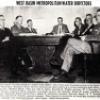
| 1854 | First water wells drilled in the West Basin. |
| 1918 | Salt water intrudes into coastal aquifers in Redondo Beach area. |
| 1922 | Groundwater drops below sea level, salt water intrudes into drinking water wells in El Segundo. |
| 1931 | Following approval of a $220 million dollar bond, Colorado River Aqueduct construction begins. |
| 1940’s | Industry increases pumping for war. |
| 1940 | Redondo Beach High School – salt water contaminates groundwater well. |
| 1940’s | Planning for State Water Project begins. |
| 1941 | Colorado River Aqueduct is complete. |
| 1942-1944 | West Basin Survey Committee formed to determine salt water damage to the groundwater supply. |
| 1944-1945 | Production is 69,476 acre feet a year. |
| 1945 | West Basin Groundwater Conservation Group (WBGCG) formed by representatives from cities, private water utilities and local industries. |
| 1945 | WBGCG releases report showing more water being withdrawn from groundwater basin than being naturally replenished and overdraft is 29,000 acre feet. Suggested corrective measures include reduce the overdraft of groundwater, educating the public about the water shortage problem and finding a source of supplemental water, including reclaiming water from the San Fernando Valley and the Owens Valley. |
| 1946 | Legal action taken to arbitrate water rights and control overdraft in California Water Service Company, et al. v. Compton, et al., L.A. County Superior Court, Case # 506,806. |
| 1946 | West Basin Water Association organizes and initiates study under Harold Conkling to determine supplemental water source needed to prevent overdraft of groundwater supplies. Conkling’s report recommends the use of Colorado River water as supplemental supply. West Basin needs majority of public to vote in support of its formation as a Municipal Water District and become member of Metropolitan Water District of Southern California (MWD). |
| 1947 | Mayors of five South Bay cities form the South Bay Water Committee.
|
| 1948 | U.S. Geological Survey releases water supply report showing fresh groundwater is threatened by salt water intrusion.
|
| 1949 | Report on reclamation is prepared for L.A. County Board of Supervisors, outlining opportunities for using reclaimed water.
|
| 1950 | In an effort to control salt water intrusion and determine effectiveness of maintaining a fresh water pressure ridge along the coast, County Flood Control begins fresh water injection tests into abandoned water well in Manhattan Beach.
|
| 1951 | Legislature amends the County Flood Control District Act to authorize establishment of conservation zones.
|
| 1952 | Report of Referee in West Basin adjudication is filed with the Court, ordering water producers to reduce groundwater extractions, requiring purchase of supplemental water to offset reduced pumping.
|
| 1953 | Test barrier, paralleling Manhattan/Hermosa Beach area, development begins.
|
| 1954 | Zone II is established to carry on barrier testing started by the State. |
| 1955 | Forty-six major groundwater producers in the West Basin voluntarily agree to restrain their groundwater extractions to 56,963 acre feet per year.
|
| 1956 | Second adjudication action filed to gain jurisdiction over new producers and those who may have been overlooked during the service of the original action. Court orders continuation of the West Basin Reference to update physical facts and directs State Water Rights Board to make these determinations. |
| 1958 | Second report was prepared for the County Board of Supervisors, affirming findings of first report from 1949. It proposes construction and operation of water reclamation plant at Whittier Narrows to demonstrate the feasibility of wastewater reclamation. |
| 1959 | Central and West Basin Water Replenishment District is formed to purchase supplemental water to replenish the depleted groundwater basins. |
| 1959 | Construction begins on State Water Project. |

| 1960 | Draft of Continued Reference Report on West Basin Adjudication is filed with the Superior Court and recommends limiting groundwater production, providing exchange for water pool, appointing a Watermaster to administer the terms and conditions of the Court, and continued jurisdiction by the Court over this Action. |
| 1961 | Aqeduct expansion complete, bringing imported water delivery capacity to 1,180,000 acre-feet annually. Court enters judgment in the original West Basin adjucation requiring groundwater production to be reduced to 64,042 acre feet. |
| 1963 | Development of test barrier paralleling the coast of Manhattan/Hermosa Beach is complete. |
| 1966 | Court enters second judgment against additional West Basin pumpers overlooked in first Action. All were made party to the terms of the original Judgment and the annual pumping was adjusted to 64,468 acre feet. Work begins on the Dominguez Gap Barrier Project to protect lower fresh water aquifers in the southeast area of the West Coast Basin from salt water intrusion. |
| 1968 | Flood Control District completes West Coast Basin Seawater Barrier consisting of 94 recharge wells injecting 50 million gallons of fresh water daily and 256 observation wells protecting groundwater supplies from salt water intrusion.
|
| 1971 | Dominguez Gap Barrier Project begins, consisting of 29 injection wells. |
| 1972 | Special water conservation area operated by the County Flood Control District for West Coast Basin ends. Entire cost of financing barrier injection programs hereafter must be supported by the water pumpers.
|
| 1973 | To prevent salt water intrusion at the southern end the County Flood Control District, additional facilities are recommended for West Coast Seawater Basin Barrier Project.
|
| 1974 | Metropolitan Water District commences delivery of State Water Project in lieu of the Colorado River to West Basin for injection into seawater barriers.
|
| 1975 | Eleven new injection wells complete in West Coast Basin Seawater Barrier Project, bringing total number of injection wells to 105. |
| 1976 | In FY 1975-76, West Basin Municipal Water District purchases 168,555 acre feet of water from Metropolitan Water District.
|
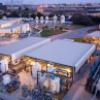
| 1987-1992 | California experiences one of its most serious droughts in history. |
| 1988 | Congress enacts Federal Disaster Assistance Act of 1988, due to extent and severity of drought.
|
| 1989 | 10 million people under drought-induced water rationing or conservations programs. |
| 1990 – 1996 | Rich Atwater joins West and Central Basins as General Manager. |
| 1991 | West Basin and City of Los Angeles reach agreement to deliver treated sewer water from the City’s Hyperion plant to a new West Basin Water Recycling Facility in El Segundo. |
| 1994 | West Basin/Hyperion Pump Station is built to pump water to facility. |
| 1995 | West Basin Water Recycling Facility construction complete, delivering water to first customer, El Segundo Lakes golf course.
|
| 1996 | West Basin Water Recycling Facility visitor’s center is complete.
|
| 1997 | Phase II Water Recycling Facility complete, expanding production capacity of tertiary and barrier water. |
| 1998 | West Basin hosts first Water Harvest festival at the Water Recycling Facility. Hollywood Park in Inglewood is 100th recycled water customer. |
| 1999 | West Basin increases percentage of near-distilled quality sewer water injected into the seawater barrier from 25 to 50 percent.
|
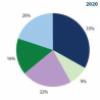
| 2000 | Phase III of the Water Recycling Facility expands capacity of microfiltration and reverse osmosis. |
| 2004 | Department of Water Resources awards West Basin $9 million Proposition 13 grant for expansion of its water recycling facilities.
|
| 2005 | West Basin’s Water Recycling Facility (WBMWRF) celebrates 10th anniversary and the following achievements:
|
| 2006 | West Basin adopts Conservation Master Plan as a guide for regional investments and translates conservation goals into tangible initiatives for residents, businesses and various levels of government.
|
| 2007 | Construction complete on Phase IV Expansion, increasing recycled water production by 15 million gallons a day. |
| 2008 | West Basin produces its 100 billionth gallon of recycled water. |
| 2010 | West Basin reaches 350 recycled water customer connections, and dedicates its demonstration ocean-water desalination facility and water education center in Redondo Beach. |
| 2018 | West Basin produces its 200 billionth gallon of recycled water. |
| 2019 | West Basin Director Gloria D. Gray begins serving two-year term as chairwoman of the Metropolitan Water District of Southern California’s Board of Directors. |
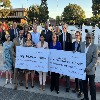
| 2020 | West Basin celebrates its 25th year of recycled water innovation, producing more than 225 billion gallons of recycled water since 1995.
|
| 2020 | West Basin announces its first delivery of recycled water to SoFi Stadium and Hollywood Park, home of the Los Angeles Rams and Los Angeles Chargers, in the city of Inglewood. This project provides 26 million gallons of recycled water per year, saving an equal amount of drinking water for the region. |
| 2021 | West Basin Board of Directors approves the District’s 2020 Urban Water Management Plan (UWMP), a strategic water resources planning guide that demonstrates West Basin’s ability to provide reliable water supplies to the region for the next 25 years. |
| 2021 | The West Basin Board terminates ocean water desalination project. |
| 2021-Present | California declares a statewide drought emergency.
|
| 2021 | West Basin Director Gloria D. Gray begins second two-year term as chairwoman of the Metropolitan Board of Directors. |
| 2022 | State Water Resources Control Board declares an emergency regulation to promote water conservation. |
| 2022 | West Basin produces its 100 billionth gallon of recycled water.
|
| 2022 | West Basin celebrates the 75th anniversary of its formation and the following achievements:
|
Photo Gallery of Historic Photos






